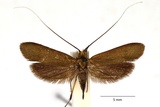Nemophora metallica (Poda, 1761) Species
Last modified: Dec. 16, 2025, 2:40 p.m.
Used to be a rather common species in Belgium, but nowadays rare and only in the southern part of the country.
Details
- Classification
- Family: Adelidae > Subfamily: Adelinae > Genus: Nemophora > Species: Nemophora metallica
- Vernacular names
- Gouden langsprietmot (NL), Brassy Long-horn (EN), l'Adèle de la scabieuse (FR), Witwenblumen-Langhornfalter (DE)
- Synonyms
- Nemophora scabiosella (Scopoli, 1763)
- First mention in Belgium
- De Sélys-Longchamps E. 1844. Énumération des insectes Lépidoptères de la Belgique. — Mémoires de la Société royale des Sciences de Liége 2: 1–35. On page 24 (as Adela scabiosella Scop.). view page
- Status
-
Native
Distribution
Caterpillar
Whitish transparent skin. Head and all three thoracic plates shining black.
Case
The case of the young larva is made of a seed capsule of Knautia of which it eats the contents. Later on, plant particles are added till the case becomes up to 12 mm, it is more or less oval.
Bionomics
The larva lives at first on the seeds of the food plant, then on the lower leaves and possibly on leaf litter, from a flat bivalved case on the ground. Pupation in the case. The moths are active during the day. They like to rest on the flowers of the larval foodplant.
Flight periods
The adults fly from mid-May to mid-August, sometimes as late as mid-September.
Habitat
Meadows, roadsides, forest edges with a lot of flowers, as long as the larval foodplant grows there as well. The species has been observed in extensively used landscapes.






